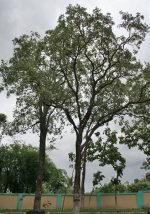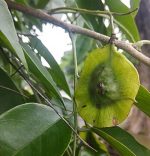 Endemic to the dry deciduous forests in the southern Eastern Ghats in South India, red sandlewood is also know as red sanders, Rakt Chandan, and saunderswood, and is a member of the pea family, Fabaceae, that also includes lupines, mimosa, and black locust. It is a small tree growing to 15-33′ tall and has dark brown fissured bark. The alternate leaves are 1-3.5″ long and trifolate with 3 leaftlets. Short dense racemes of yellow flowers appear from late winter to spring and give way to a winged seed pod 2.4-3.5″ long and containing 1-2 reddish- brown seeds. Photo Credit J M Garg Wikipedia The identification of red sandalwood in the Bible is difficult due to the fact that scholars disagree on the relationship of the words almug and algum. Some think they refer to different plants, others think the word has just been mispelled and refer to the same plant. The problem is further complicated by the fact that scholars do not agree on the location of Ophir, the supposed source of the almug trees. The most popular alternative choice for almug tree is white sandalwood, Santalum album, that also has fragrant wood used for sacrifices, jewelry, and musical instruments, but is too small to provide the timber suitable for the supports and steps of the temple as mentioned in the passages.
Endemic to the dry deciduous forests in the southern Eastern Ghats in South India, red sandlewood is also know as red sanders, Rakt Chandan, and saunderswood, and is a member of the pea family, Fabaceae, that also includes lupines, mimosa, and black locust. It is a small tree growing to 15-33′ tall and has dark brown fissured bark. The alternate leaves are 1-3.5″ long and trifolate with 3 leaftlets. Short dense racemes of yellow flowers appear from late winter to spring and give way to a winged seed pod 2.4-3.5″ long and containing 1-2 reddish- brown seeds. Photo Credit J M Garg Wikipedia The identification of red sandalwood in the Bible is difficult due to the fact that scholars disagree on the relationship of the words almug and algum. Some think they refer to different plants, others think the word has just been mispelled and refer to the same plant. The problem is further complicated by the fact that scholars do not agree on the location of Ophir, the supposed source of the almug trees. The most popular alternative choice for almug tree is white sandalwood, Santalum album, that also has fragrant wood used for sacrifices, jewelry, and musical instruments, but is too small to provide the timber suitable for the supports and steps of the temple as mentioned in the passages.
1 Kings 10:11-12 (NIV) When the Queen of Sheba arrived at Jerusalem to visit Solomon, they exchanged gifts.
11 “(Hiram’s ships brought gold from Ophir; and from there they brought great cargoes of almugwood and precious stones.
12 . The king used the almugwood to make supports for the temple of the LORD and for the royal palace, and to make harps and lyres for the musicians. So much almugwood has never been imported or seen since that day.)”
II Chronicles 9:10-11 (NIV) (same context as above)
10. ” (The servants of Hiram and the servants of Solomon brought gold from Ophir; they also brought algumwood and precious stones.
11. The king used the algumwood to make steps for the temple of the LORD and for the royal palace, and to make harps and lyres for the musicians. Nothing like them had ever been seen in Judah.)”
 Red sandalwood likes full sun and average, medium moist, well-drained acid soil in USDA Hardiness Zones 9-13 but does well in poor soil and tolerates a dry season. Propagation is by seed that is viable for about 1 year. Caterpillars may damage the leaves. The tree has numerous medicinal uses and is highly valued for its timber that is used for such items furniture, building, carving and musical instruments, and a red pigment derived from the wood is used for a food dye. High demand and illegal harvesting of the tree has caused it to be classified as a threatened species.
Red sandalwood likes full sun and average, medium moist, well-drained acid soil in USDA Hardiness Zones 9-13 but does well in poor soil and tolerates a dry season. Propagation is by seed that is viable for about 1 year. Caterpillars may damage the leaves. The tree has numerous medicinal uses and is highly valued for its timber that is used for such items furniture, building, carving and musical instruments, and a red pigment derived from the wood is used for a food dye. High demand and illegal harvesting of the tree has caused it to be classified as a threatened species.
The genus name, Pterocarpus, come from the Greek words pteron meaning wing and carpos meaning fruit and refers to the winged seed pod. The specific epither, santalinus, comes from the Greek word santalon, meaning the sandalwood tree.
Photo Credit: Aris-Riyanto-Wikipedia